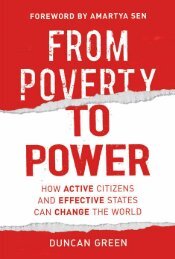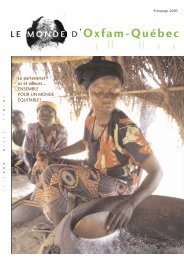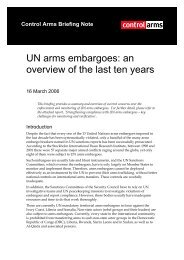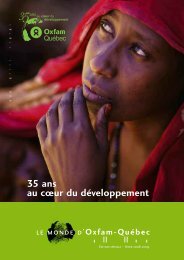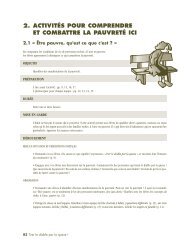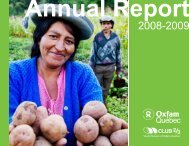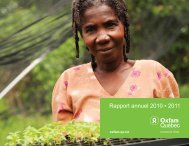Africa's Missing Billions - Oxfam International
Africa's Missing Billions - Oxfam International
Africa's Missing Billions - Oxfam International
Create successful ePaper yourself
Turn your PDF publications into a flip-book with our unique Google optimized e-Paper software.
Notes1 <strong>International</strong> Action Network on Small Arms (IANSA) (2006) ‘Bringing the globalgun crisis under control’, http://www.iansa.org/members/IANSA-media-briefing-lowres.pdf(last checked by the author August 2007).2 Using data from Annex 2 of Muggah R. (2007: forthcoming) ‘A hard pill to swallow:risk factors and impacts of collective violence on population health in Africa’,WHO/AFRO chapter on collective armed violence.3 See SIPRI 2007 Yearbook, chapter 2 and the work of the Human Security Centre:www.humansecuritycentre.org4 From 1990 to 2003. UNDP (2005) Human Development Report, p.154.http://hdr.undp.org/reports/global/2005/pdf/HDR05_chapter_5.pdf5 HIIK (2006) ‘Conflict Barometer 2006’, p.3. Heidelberg Institute for <strong>International</strong>Conflict Research at the Department of Political Science, University of Heidelberg.6 Collier, P. (2007) The Bottom Billion: Why the poorest countries are failing and whatcan be done about it, Oxford: Oxford University Press.7 UN Millennium Project (2005) ‘Investing in Development: A practical plan to achievethe MDGs: Overview’, New York.8 See, for example, Batchelor P. and S. Demetriou (2005) ‘Securing Development:UNDP’s support for addressing small arms issues’, UNDP. Also, according to the2005 Human Development Report: ‘Insecurity linked to armed conflict remains one ofthe greatest obstacles to human development. It is both a cause and consequence ofmass poverty.’9 Average of IMR as infant deaths per 1,000 live births: 105.5 for conflict countries,68 for non-conflict countries. Source: World Bank (2007) ‘World DevelopmentIndicators 2007’,web.worldbank.org/WBSITE/EXTERNAL/DATASTATISTICS/0,,contentMDK:21298138~pagePK:64133150~piPK:64133175~theSitePK:239419,00.html (last checked bythe author in May 2007)10 Average of undernourishment as a percentage of population: 35.5 per cent forconflict countries, 21.8 per cent for non-conflict countries. Source: World Bank(2007b) ‘Health, Nutrition and Population Data’,http://devdata.worldbank.org/hnpstats (last checked by the author May 2007).11 Average life expectancy: 48.31 for conflict countries, 53.19 for non-conflictcountries. Source: World Bank (2007) World Development Indicators 2007, op. cit.12 Average adult literacy: 48 per cent for conflict countries, 68 per cent for nonconflictcountries. Source: World Bank (2007) World Development Indicators 2007,op. cit.13 Average of physicians per 1,000 people: 0.14 for conflict countries, 0.37 for nonconflictcountries. Source: World Bank (2007) World Development Indicators 2007,op. cit.14 This data was not calculated by <strong>Oxfam</strong>. It applies to sub-Saharan Africa during1970–93. Source: Messer, E., M. J. Cohen, and J. D’Costa (1998) ‘Food from peace:Breaking the links between conflict and hunger’http://www.ifpri.org/2020/briefs/number50.htm (last checked by the author August2007)30Africa’s missing billions, IANSA, <strong>Oxfam</strong>, and Saferworld, October2007




